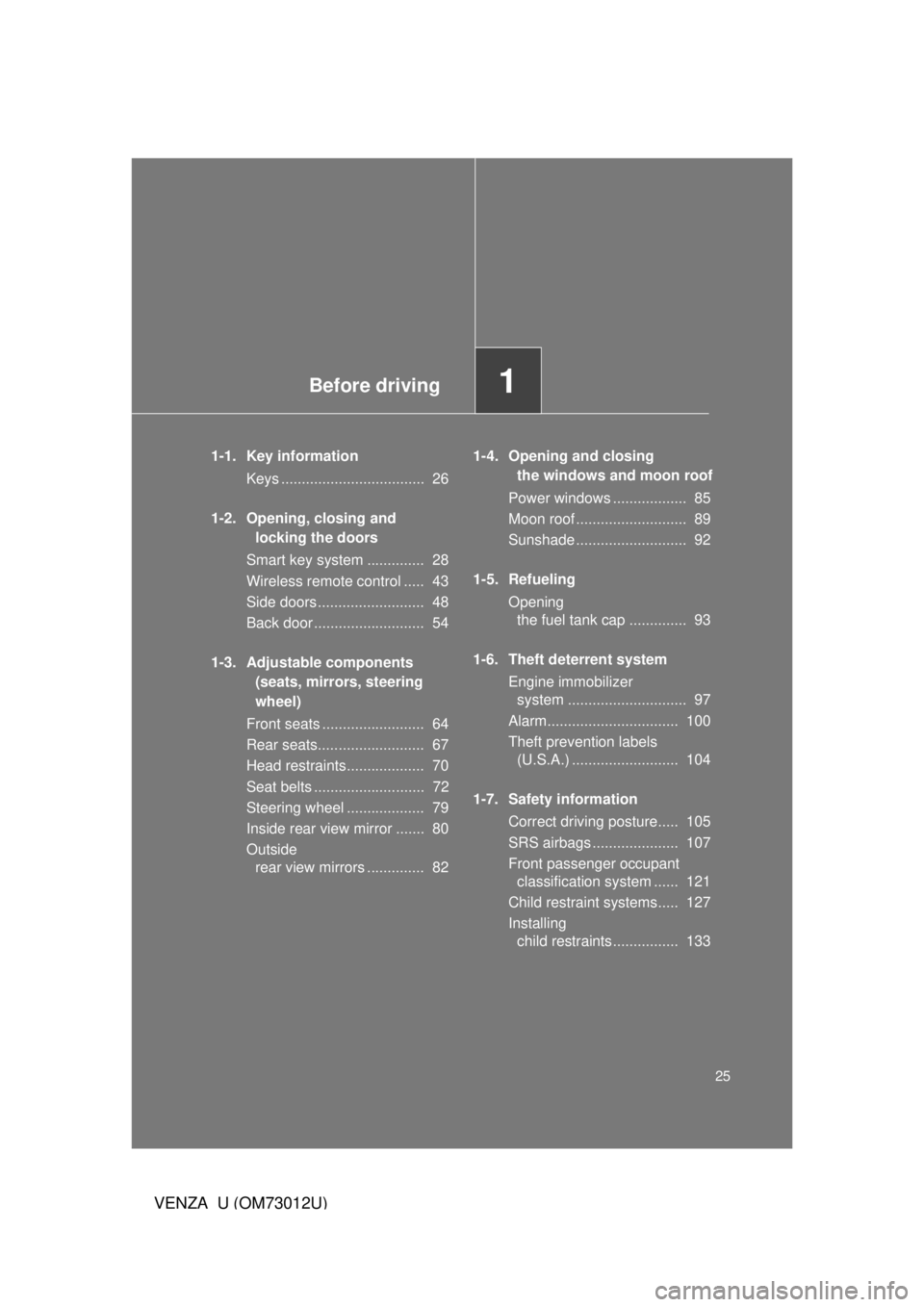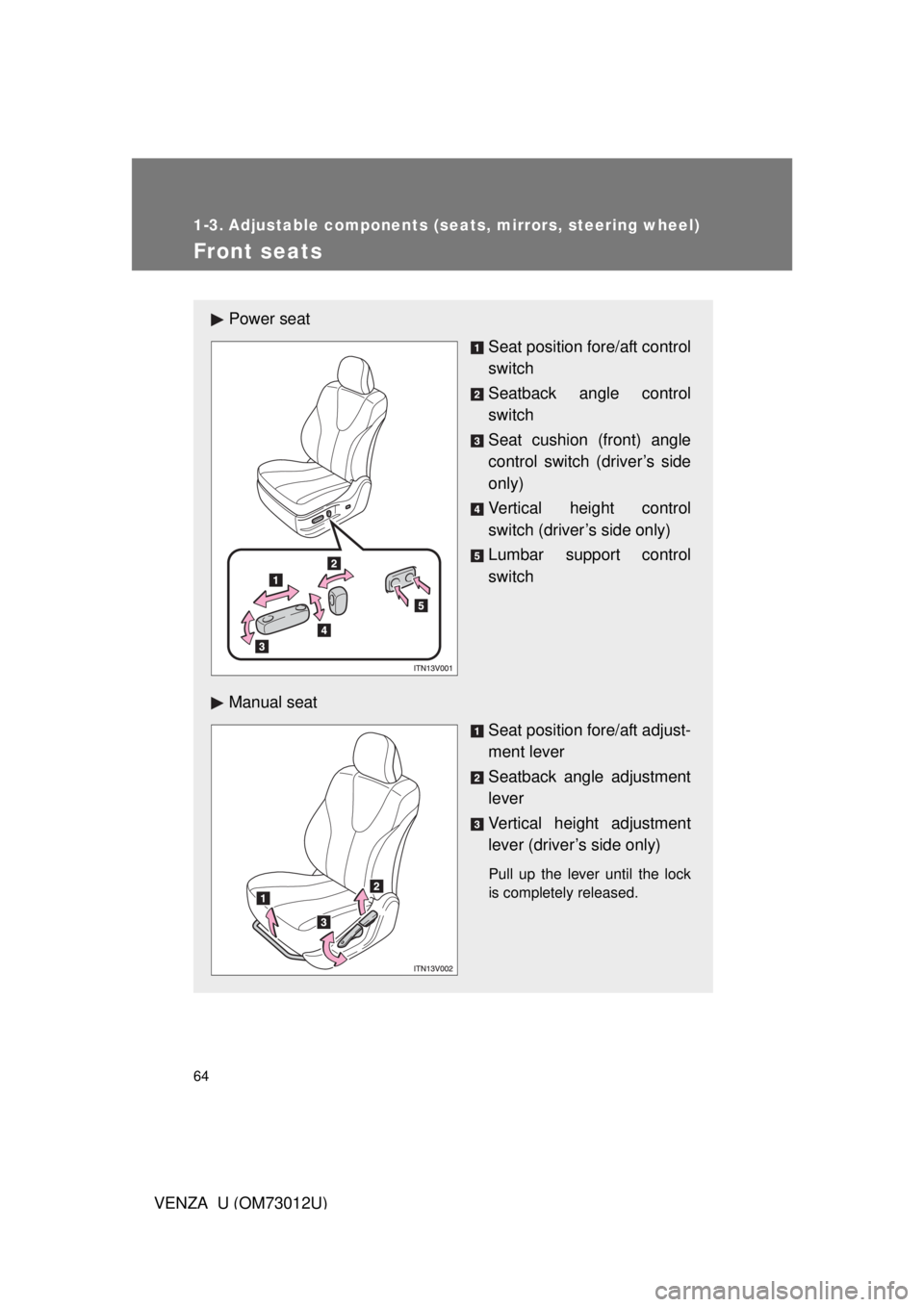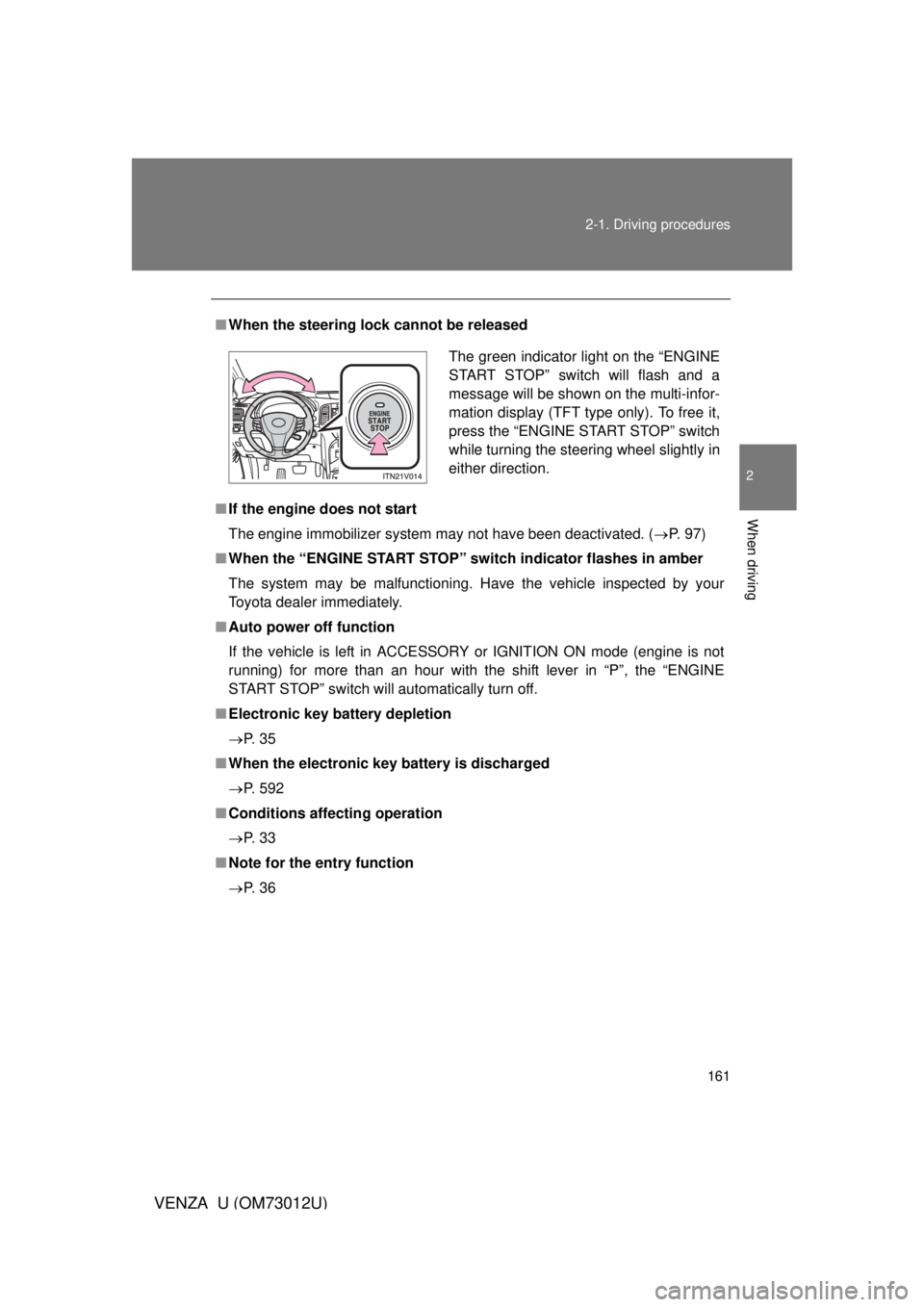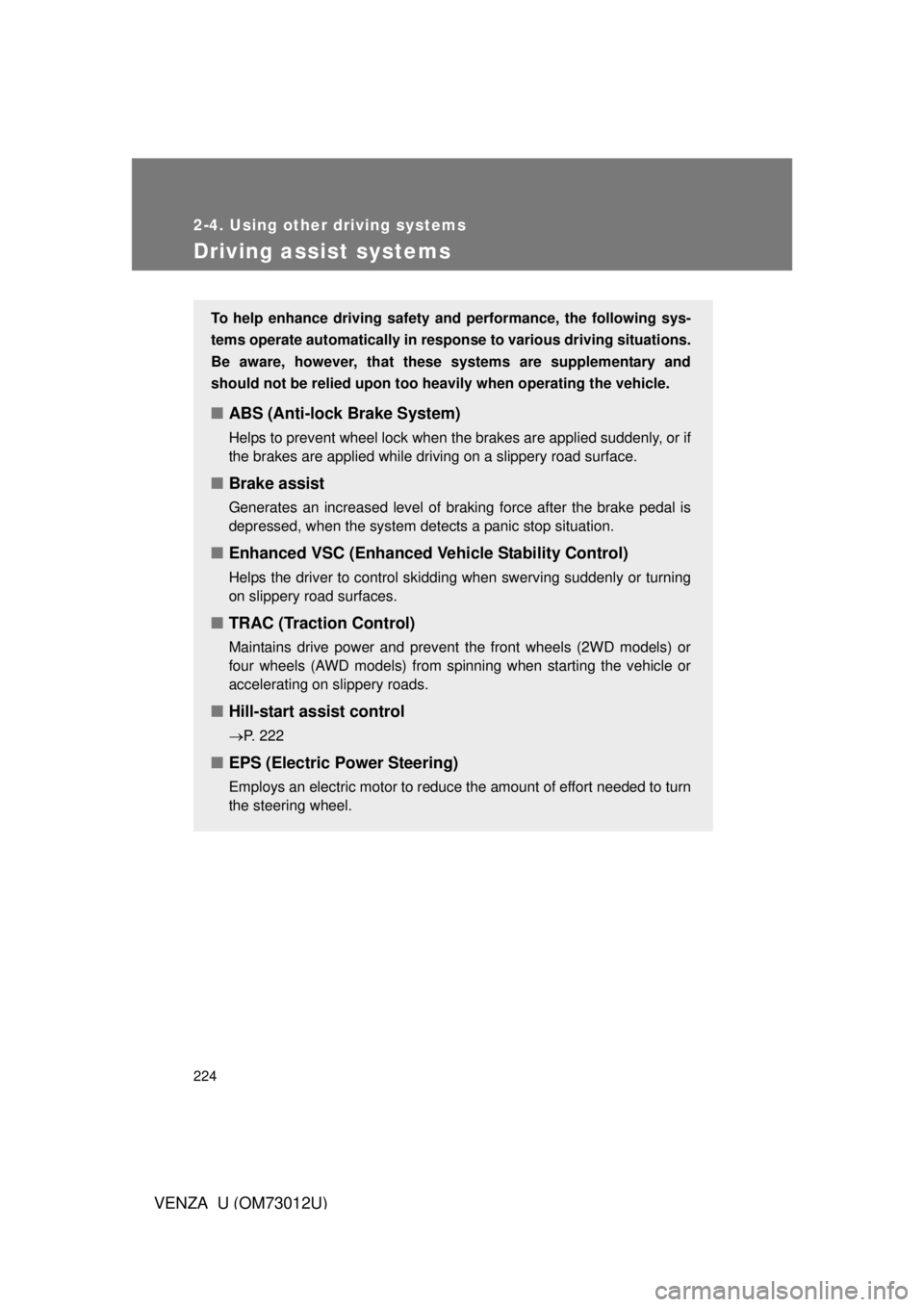power steering TOYOTA VENZA 2011 Owners Manual (in English)
[x] Cancel search | Manufacturer: TOYOTA, Model Year: 2011, Model line: VENZA, Model: TOYOTA VENZA 2011Pages: 680, PDF Size: 13.69 MB
Page 2 of 680

TABLE OF CONTENTSIndex
2
VENZA_U (OM73012U)
1-1. Key informationKeys ..................................... 26
1-2. Opening, closing and
locking the doors
Smart key system................. 28
Wireless remote control ....... 43
Side doors ............................ 48
Back door ............................. 54
1-3. Adjustable components
(seats, mirrors, steering
wheel)
Front seats ........................... 64
Rear seats ............................ 67
Head restraints ..................... 70
Seat belts ............................. 72
Steering wheel ..................... 79
Inside rear view mirror.......... 80
Outside rear view mirrors ..... 82
1-4. Opening and closing the win dows and moon roof
Power windows .................... 85
Moon roof ............................. 89
Sunshade ............................. 92 1-5. Refueling
Opening the fuel tank cap ................. 93
1-6. Theft deterrent system Engine immobilizer system ................................ 97
Alarm .................................. 100
Theft prevention labels (U.S.A.) ............................. 104
1-7. Safety information Correct driving posture ....... 105
SRS airbags ....................... 107
Front passenger occupant classification system ......... 121
Child restraint systems ....... 127
Installing child restraints ..... 133
2-1. Driving procedures Driving the vehicle .............. 148
Engine (ignition) switch (vehicles with
smart key system) ............ 159
Engine (ignition) switch (vehicles without
smart key system) ............ 163
Automatic transmission ...... 166
Turn signal lever ................. 171
Parking brake ..................... 172
Horn .................................... 173
1Before driving
2When driving
Page 25 of 680

Before driving1
25
VENZA_U (OM73012U)
1-1. Key informationKeys ................................... 26
1-2. Opening, closing and locking the doors
Smart key system .............. 28
Wireless remote control ..... 43
Side doors .......................... 48
Back door ........................... 54
1-3. Adjustable components (seats, mirrors, steering
wheel)
Front seats ......................... 64
Rear seats.......................... 67
Head restraints................... 70
Seat belts ........................... 72
Steering wheel ................... 79
Inside rear view mirror ....... 80
Outside rear view mirrors .............. 82 1-4. Opening and closing
the windows and moon roof
Power windows .................. 85
Moon roof ........................... 89
Sunshade ........................... 92
1-5. Refueling Opening the fuel tank cap .............. 93
1-6. Theft deterrent system Engine immobilizer system ............................. 97
Alarm................................ 100
Theft prevention labels (U.S.A.) .......................... 104
1-7. Safety information Correct driving posture..... 105
SRS airbags ..................... 107
Front passenger occupant classification system ...... 121
Child restraint systems..... 127
Installing child restraints ................ 133
Page 64 of 680

64
VENZA_U (OM73012U)
1-3. Adjustable components (seats, mirrors, steering wheel)
Front seats
Power seat
Seat position fore/aft control
switch
Seatback angle control
switch
Seat cushion (front) angle
control switch (driver’s side
only)
Vertical height control
switch (driver’s side only)
Lumbar support control
switch
Manual seat Seat position fore/aft adjust-
ment lever
Seatback angle adjustment
lever
Vertical height adjustment
lever (driver’s side only)
Pull up the lever until the lock
is completely released.
Page 110 of 680

110 1-7. Safety information
VENZA_U (OM73012U)Your vehicle is equipped with “ADVANCED AIRBAGS” designed
based on US motor vehicle safety standards (FMVSS208). The air-
bag system controls airbag deploy
ment power for the driver and front
passenger. The driver airbag system consists of the driver seat’s
position sensor etc. The front pass enger’s airbag system consists of
the front passenger occupant classification sensor etc.
The main SRS airbag system components are shown above. The
SRS airbag system is controlled by the airbag sensor assembly. The
airbag sensor assembly consists of a safing sensor and an airbag
sensor.
In certain types of severe frontal or side impacts, the SRS airbag sys-
tem triggers the airbag inflators. A chemical reaction in the inflators
quickly fills the airbags with non-toxic gas to help restrain the motion
of the occupants.
■ If the SRS airbags deploy (inflate)
● Bruising and slight abrasions may result from contact with a deploying
(inflating) SRS airbag.
● A loud noise and white powder will be emitted.
● Parts of the airbag module (steering wheel hub, airbag cover and inflator)
as well as the front seats and parts of the front and rear pillars, and roof
side rail, may be hot for several minutes. The airbag itself may also be
hot.
● The windshield may crack.
Page 152 of 680

152 2-1. Driving procedures
VENZA_U (OM73012U)
CAUTION
●Do not shift the shift lever to “D” while the vehicle is moving backward.
Doing so can damage the transmission and may result in a loss of vehicle\
control.
● Moving the shift lever to “N” while the vehicle is moving will disengage the
engine from the transmission. Engine br aking is not available when “N” is
selected.
● During normal driving, do not turn off the engine. Turning the engine off
while driving will not cause loss of steering or braking control, but the
power assist to these systems will be lost. This will make it more difficult to
steer and brake, so you should pull over and stop the vehicle as soon as it
is safe to do so.
However, in the event of an emergency, such as if it becomes impossible
to stop the vehicle in the normal way: P. 605.
● Use engine braking (downshift) to maintain a safe speed when driving
down a steep hill.
Using the brakes continuously may cause the brakes to overheat and lose
effectiveness. ( P. 167)
● When stopped on an inclined surface, use the brake pedal and parking
brake to prevent the vehicle from rolling backward or forward and causing
an accident.
● Do not adjust the position of the steering wheel, the seat, or the inside or
outside rear view mirrors while driving.
Doing so may result in a loss of vehicle control that can cause accidents
that may result in death or serious injury.
● Always check that all passengers’ arms, heads or other parts of their bod-
ies are not outside the vehicle, as this may result in death or serious injury.
● Do not drive in excess of the speed limit. Even if the legal speed limit per-
mits it, do not drive over 85 mph (140 km/h) unless your vehicle has high-
speed capability tires. Driving over 85 mph (140 km/h) may result in tire
failure, loss of control and possible injury. Be sure to consult a tire dealer
to determine whether the tires on your vehicle are high-speed capability
tires or not before driving at such speeds.
Page 157 of 680

157
2-1. Driving procedures
2
When driving
VENZA_U (OM73012U)
NOTICE
■
While driving the vehicle
● Do not depress the accelerator and brake pedals at the same time during
driving. If the brake pedal is depressed while driving with the accelerator
pedal depressed, driving torque may be restrained.
● Do not use the accelerator pedal or depress accelerator and brake pedals
together to hold the vehicle on a hill.
■ When parking the vehicle
Always put the shift lever in “P”. Failure to do so may cause the vehicle to
move or the vehicle may accelerate suddenly if the accelerator pedal is acci-
dentally depressed.
■ Avoiding damage to vehicle parts
● Do not turn the steering wheel fully in either direction and hold it there for a
long time.
Doing so may damage the power steering motor.
● When driving over bumps in the road, drive as slowly as possible to avoid
damaging the wheels, underside of the vehicle, etc.
■ If you hear a squealing or scrapin g noise (brake pad wear limit indica-
tors)
Have your Toyota dealer check and replace the brake pads as soon as pos-
sible.
The rotor damage can result if the pads are not replaced when needed.
It is dangerous to drive the vehicle when the wear limits of the brake pads
and/or that of the brake discs are exceeded.
Page 161 of 680

161
2-1. Driving procedures
2
When driving
VENZA_U (OM73012U)
■
When the steering lock cannot be released
■ If the engine does not start
The engine immobilizer system may not have been deactivated. ( P. 97)
■ When the “ENGINE START STOP” switch indicator flashes in amber
The system may be malfunctioning. Have the vehicle inspected by your
Toyota dealer immediately.
■ Auto power off function
If the vehicle is left in ACCESSORY or IGNITION ON mode (engine is not
running) for more than an hour with the shift lever in “P”, the “ENGINE
START STOP” switch will automatically turn off.
■ Electronic key battery depletion
P. 3 5
■ When the electronic key battery is discharged
P. 592
■ Conditions aff ecting operation
P. 3 3
■ Note for the entry function
P. 3 6
The green indicator light on the “ENGINE
START STOP” switch will flash and a
message will be shown on the multi-infor-
mation display (TFT type only). To free it,
press the “ENGINE START STOP” switch
while turning the steering wheel slightly in
either direction.
Page 162 of 680

162 2-1. Driving procedures
VENZA_U (OM73012U)
CAUTION
■When starting the engine
Always start the engine while sitting in the driver’s seat. Do not depress the
accelerator pedal while starting the engine under any circumstances.
Doing so may cause an accident resulting in death or serious injury.
■ Stopping the engine in an emergency
If you want to stop the engine in an emergency while driving the vehicle,
push and hold the “ENGINE START STOP” switch for more than 3 seconds.
However, do not touch the “ENGINE START STOP” switch while driving
except in an emergency. Turning the engine off while driving will not cause
loss of steering or braking control, but the power assist to these systems will
be lost. This will make it more difficult to steer and brake, so you should pull
over and stop the vehicle as soon as it is safe to do so.
NOTICE
■To prevent battery discharge
Do not leave the “ENGINE START STOP” switch in ACCESSORY or IGNI-
TION ON mode for long periods without the engine running.
■ When starting the engine
● Do not race a cold engine.
● If the engine becomes difficult to start or stalls frequently, have the engine
checked immediately.
Page 224 of 680

224
2-4. Using other driving systems
VENZA_U (OM73012U)
Driving assist systems
To help enhance driving safety and performance, the following sys-
tems operate automatically in res ponse to various driving situations.
Be aware, however, that these systems are supplementary and
should not be relied upon too h eavily when operating the vehicle.
■ABS (Anti-lock Brake System)
Helps to prevent wheel lock when the brakes are applied suddenly, or if
the brakes are applied while driving on a slippery road surface.
■Brake assist
Generates an increased level of braking force after the brake pedal is
depressed, when the system detects a panic stop situation.
■Enhanced VSC (Enhanced Vehicle Stability Control)
Helps the driver to control skidding when swerving suddenly or turning
on slippery road surfaces.
■TRAC (Traction Control)
Maintains drive power and prevent the front wheels (2WD models) or
four wheels (AWD models) from spinning when starting the vehicle or
accelerating on slippery roads.
■Hill-start assist control
P. 222
■ EPS (Electric Power Steering)
Employs an electric motor to reduce the amount of effort needed to turn
the steering wheel.
Page 228 of 680

228 2-4. Using other driving systems
VENZA_U (OM73012U)
■EPS operation sound
When the steering wheel operates, a motor sound (whirring sound) may be
heard.
This does not indicate a malfunction.
■ Reduced effectiveness of EPS
The effectiveness of EPS is reduced to prevent the system from overheating
when there is frequent steering input over an extended period of time. The
steering wheel may feel heavy as a result. Should this occur, refrain from
excessive steering input or stop the vehicle and turn the engine off. The sys-
tem should return to normal within 10 minutes.
CAUTION
■The ABS does not operate effectively when
● The limits of tire gripping performance have been exceeded.
● The vehicle hydroplanes while driving at high speed on the wet or slick
road.
■ Stopping distance when the ABS is ope rating on the wet or slick roads
The ABS is not designed to shorten the vehicle’s stopping distance. Always
maintain a safe distance from the vehicle in front of you in the following situ-
ations.
● When driving on dirt, gravel or snow-covered roads
● When driving with tire chains
● When driving over bumps in the road
● When driving over roads with pothol es or roads with uneven roads
■ TRAC may not operate effectively when
Directional control and power may not be achievable while driving on slip-
pery road surfaces, even if the TRAC is operating.
Do not drive the vehicle in conditions where stability and power may be lost.